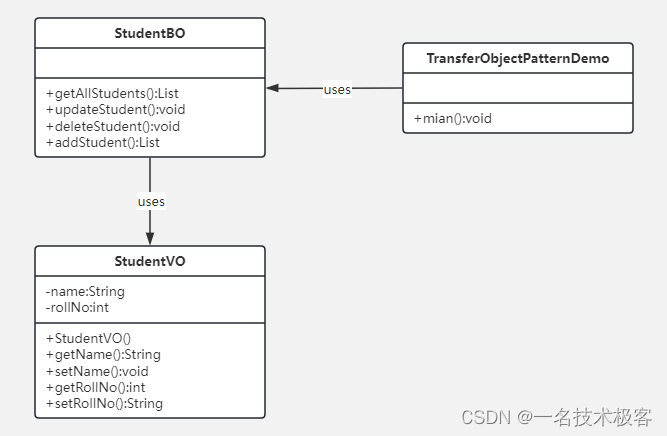草包做視頻網(wǎng)站北京今日重大新聞
Java傳輸對象模式
- 實現(xiàn)
- 范例
- 傳輸對象模式(Transfer Object Pattern)用于從客戶端向服務(wù)器一次性傳遞帶有多個屬性的數(shù)據(jù)
- 傳輸對象也被稱為數(shù)值對象,沒有任何行為
- 傳輸對象是一個具有 getter/setter 方法的簡單的 POJO 類,它是可序列化的,所以它可以通過網(wǎng)絡(luò)傳輸
- 服務(wù)器端的業(yè)務(wù)類通常從數(shù)據(jù)庫讀取數(shù)據(jù),然后填充 POJO,并把它發(fā)送到客戶端或按值傳遞它
- 對于客戶端,傳輸對象是只讀的
- 客戶端可以創(chuàng)建自己的傳輸對象,并把它傳遞給服務(wù)器,以便一次性更新數(shù)據(jù)庫中的數(shù)值
- 以下是這種設(shè)計模式的實體:
- 業(yè)務(wù)對象(Business Object) - 為傳輸對象填充數(shù)據(jù)的業(yè)務(wù)服務(wù)
- 傳輸對象(Transfer Object) - 簡單的 POJO,只有設(shè)置/獲取屬性的方法
- 客戶端(Client) - 客戶端可以發(fā)送請求或者發(fā)送傳輸對象到業(yè)務(wù)對象
實現(xiàn)

- 創(chuàng)建一個作為業(yè)務(wù)對象的 StudentBO 和作為傳輸對象的 StudentVO ,它們都代表了我們的實體
- TransferObjectPatternDemo ,我們的演示類在這里是作為一個客戶端,將使用 StudentBO 和 Student 來演示傳輸對象設(shè)計模式
范例
1. 創(chuàng)建傳輸對象 StudentVO
StudentVO.java
package com.demo.gof;
public class StudentVO{private String name;private int rollNo;StudentVO(String name, int rollNo){this.name = name;this.rollNo = rollNo;}public String getName() {return name;}public void setName(String name) {this.name = name;}public int getRollNo() {return rollNo;}public void setRollNo(int rollNo) {this.rollNo = rollNo;}
}
2. 創(chuàng)建業(yè)務(wù)對象 StudentBO
StudentBO.java
package com.demo.gof;
import java.util.ArrayList;
import java.util.List;public class StudentBO {//列表是當(dāng)作一個數(shù)據(jù)庫List<StudentVO> students;public StudentBO(){students = new ArrayList<StudentVO>();StudentVO student1 = new StudentVO("Robert",0);StudentVO student2 = new StudentVO("John",1);students.add(student1);students.add(student2); }public void deleteStudent(StudentVO student) {students.remove(student.getRollNo());System.out.println("Student: Roll No " + student.getRollNo() +", deleted from database");}//從數(shù)據(jù)庫中檢索學(xué)生名單public List<StudentVO> getAllStudents() {return students;}public StudentVO getStudent(int rollNo) {return students.get(rollNo);}public void updateStudent(StudentVO student) {students.get(student.getRollNo()).setName(student.getName());System.out.println("Student: Roll No " + student.getRollNo() +", updated in the database");}
}3. 使用 StudentBO 來演示傳輸對象設(shè)計模式
TransferObjectPatternDemo.java
package com.demo.gof;
public class TransferObjectPatternDemo {public static void main(String[] args) {StudentBO studentBusinessObject = new StudentBO();//輸出所有的學(xué)生for (StudentVO student : studentBusinessObject.getAllStudents()) {System.out.println("Student: [RollNo : "+student.getRollNo()+", Name : "+student.getName()+" ]");}//更新學(xué)生StudentVO student =studentBusinessObject.getAllStudents().get(0);student.setName("Michael");studentBusinessObject.updateStudent(student);//獲取學(xué)生studentBusinessObject.getStudent(0);System.out.println("Student: [RollNo : "+student.getRollNo()+", Name : "+student.getName()+" ]");}
}
編譯運(yùn)行以上 Java 范例,輸出結(jié)果如下
$ javac -d . src/main/com.demo/gof/TransferObjectPatternDemo.java
$ java com.ddkk.demo.TransferObjectPatternDemo
Student: [RollNo : 0, Name : Robert ]
Student: [RollNo : 1, Name : John ]
Student: Roll No 0, updated in the database
Student: [RollNo : 0, Name : Michael ]
